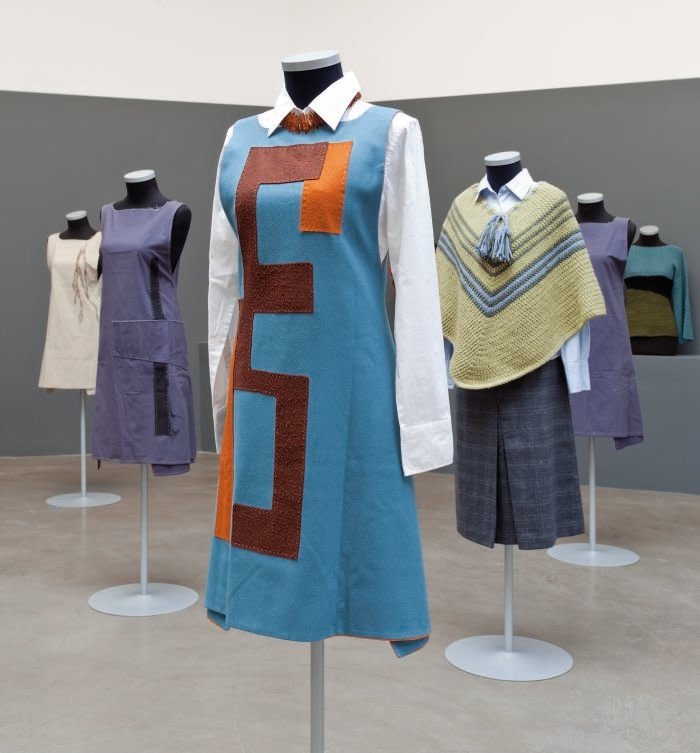Wear with all — the art of Andrea Zittel
Simply sign up to the Style myFT Digest -- delivered directly to your inbox.

‘My hope is that wearing them will inspire people to experiment with new ways to reinvent the rectangle,” says American artist Andrea Zittel. She is talking about her panel garments, utilitarian, unisex wrap designs which will be available for visitors to borrow from next month at the exhibition Palimpsest at Lismore Castle in Ireland. The idea is simple: see the show, wear a piece of it home.
Palimpsest is a group show that I’m curating, bringing together work by artists looking at different uses of locations or objects across time. It is my first exhibition. Lismore is a small town in Ireland, which in the 700s AD, was the home of a famous university. It was completely sacked by Vikings 100 years later.
On the same land today sits the nine-century-old Lismore Castle: the Lismore Castle Arts sits within its lush garden setting. It is a place of such impossible beauty, that it can seem as though rendered for the set of Game of Thrones. When I first looked at it, it made me wonder at how locations have completely different uses over time — which essentially inspired the title of this show.
The exhibition features pieces by some of my favourite artists — works by current Turner Prize winner Charlotte Prodger, Nicole Eisenman, Zoe Leonard, Hilary Lloyd, Martine Syms and Lynette Yiadom-Boakye. But I have long been obsessed with Andrea Zittel, an artist who focuses on ways of living.
Her home is A-Z West, a 70-acre artwork in the California high desert next to Joshua Tree National Park, which houses experimental cabins and pods. “A-Z West is a compound where I have been working on experimental living structures for the last 19 years,” she says.

Throughout her career, Zittel has used her home, and her clothes, as a means to explore her subject. “My artwork, as well as my lived life, revolves around the contradictory nature of freedom,” she says. “I’ve spent time living in the confines of prescribed spaces, living without time for periods, eating and drinking only out of bowls, or living without running water or electric light.”
Her work is designed to question the constraints of a supposedly free society. “My experiments question the definition of freedom as it is framed by capitalist society,” says Zittel. “Perhaps the only way to truly be free is to make our own rules.”

Since the early 1990s, Zittel’s daily dress has been dictated by her A-Z Uniforms Project. It began when she lived in a tiny storefront in Brooklyn where there was no space for a wardrobe. It became an early work. “If I had a single personal uniform,” she says, “it wouldn’t take any room to store. I put my energy and resources into making the perfect garment that could be worn day after day.”
Over the years, the uniforms have gone through different variations. Initially she only made garments from rectangles; there was a period where garments were made from a single thread, from start to finish. She used to change her uniform every season, but recently the pace has changed. “Now I am more interested in finding the ultimate system for dressing that doesn’t necessarily need to be reinvented each season,” she says.
Zittel also weaves her own fabric, with a studio of looms set up at A-Z West. It was this weaving that bridged her work to Ireland, where the traditions of Irish tweed are today being upheld by a new generation of weavers and designers, such as Molloy & Sons of Donegal and the Tweed Project of Galway. Last year, I emailed Zittel and asked if she’d be interested in working with Irish weavers.

It was Zittel’s idea to make garments in tweed that could then be borrowed, like a lending library. Zittel has designed her own tweed, which is currently being woven by Molly & Sons. The pieces will then be made by The Tweed Project, who specialise in making contemporary pieces from traditional cloths. We will keep a couple of the finished garments on mannequins in the gallery. The rest will be there for visitors to borrow. Each time it is worn, it becomes a “palimpsest” — a different use for the same object.
“I’ve always wanted my work to travel out into the world,” says Zittel, “and for people to have the opportunity to engage directly with it, in a way that’s not confined to the awkwardness of the exhibition space.”
The garment returns to Zittel’s interest in the rectangle, with a panel of tweed that is then wrapped around the body, held by two broad shoulder straps. “Allowing people to borrow the garments, take them home, experiment with them in front of the mirror or wear them out at night just seems so much better than keeping them confined to the gallery.”

I have always loved how Zittel’s work breaks free from the traditional exhibition space. There is an urgency about it, which questions how we live and what we wear. By creating garments that will be worn by different people in different situations, Zittel is allowing people to become part of the artwork.
“If I’m really honest, I have no idea what will really happen,” she says, “or who would be interested in wearing these, or even if anyone will want to do it. It is the unknowns that make this project interesting.”
Do people want to wear borrowed clothes? It is a question that some see as an alternative to the consumer cycle of fashion. Websites such as renttherunway.com, where clothes are borrowed to wear for a fee and then returned, rely on customer willingness to switch from owning what they wear. There is a similar break from art world norms in Zittel’s work. It’s like she has created for herself a parallel universe where she can define what it means to be an artist, how an artist lives, and how others engage in their work.
“It’s important that each person make their own rules for how they dress, eat, sleep and so on,” says Zittel. Her interest is not in imposing her own strict criteria on anyone else. She just hopes to encourage others to think about how they live for themselves. “Maybe this project will inspire people to make their own rules,” she says, “or their own uniforms.”
Palimpsest is at Lismore Castle Arts from 31 March-13 October

Comments